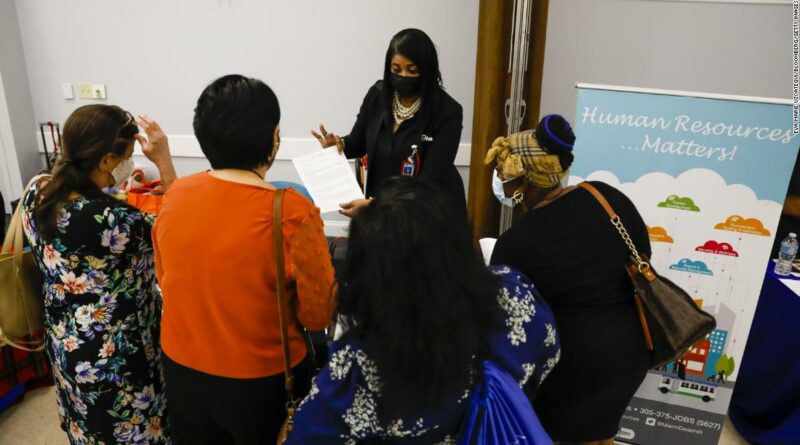US economic growth in 2021 was the strongest since 1984
Asutosh Padhi is McKinsey & Company’s managing partner for North America. The opinions expressed in this commentary are his own.
As the managing partner for McKinsey in North America, I talk to CEOs every week, and I keep hearing the same thing across all industries and regions of the US: We’re in one of the most bewildering labor markets in a generation.
Job openings remain dramatically higher than pre-pandemic levels. Yet the December unemployment data from the U.S. Bureau of Labor Statistics shows a disproportionate number of minorities, younger workers and people without four-year degrees remain unemployed.
This mismatch may seem intractable, but I’m optimistic from my conversations with business leaders that they can close this gap and realize a new era of sustainable and inclusive growth.
Here are three steps they can take.
Focus on skills, not degrees
In a recent McKinsey survey, a majority of respondents (58%) said that closing skill gaps in their companies’ workforces has become a higher priority since the pandemic began, and 69% said their companies engage in more skill building than they did before the Covid-19 crisis. Current employment practices emphasize traditional degrees and experience in the same field, leaving companies short of staff. For workers without degrees, this practice carries harsh implications: McKinsey’s latest American Opportunity Survey found less than half of Americans without degrees reported they could cover more than two months of expenses if they lost their jobs.
Expanding recruitment efforts to people who have work experience but don’t have degrees could open significant opportunities for job seekers, while broadening the talent pipeline for companies.
Business leaders could support more “gateway jobs,” or stepping-stone positions that provide an income boost while also improving workers’ trajectories toward more resilient, higher-wage, higher-quality jobs. Picture a former retail worker who draws on their experience in customer service and numerical skills to move into a manufacturing sales rep role and, over time, progresses to a sales manager.
Leaders can also challenge their organizations to embrace a more inclusive, skills-based approach to hiring and talent management. They can start by updating job postings to favor skills and competencies that can be transferred from other sectors, instead of relying on past job titles or degrees.
Such efforts could also create opportunities to accelerate the return of women who left the workforce in higher numbers amid the pandemic. For example, companies could remove requirements for recent experience or skills that can be learned on the job. Companies can also consider creating “on-ramp” programs to help women reenter the workforce without losing progress they earned earlier in their career.
Accelerate workforce training programs
The pandemic accelerated technology adoption, but workforce training programs haven’t kept pace. The chasm between the skills of today and the jobs of tomorrow will widen as demand for technological, social, emotional and higher cognitive skills grows. Developing iron-clad, scalable training programs is an important long-term strategy.
An estimated 17 million US workers will need to be reskilled and redeployed into new occupations to remain employed by 2030, according to a 2021 McKinsey report. This may be especially disruptive for women, for whom long-established barriers and “double shifts” with work at home and “triple shifts” — with extra responsibilities many have assumed in the workplace — could make career transitions even more difficult.
Business leaders should explore more ways to offer their employees education outside the workplace, or as part of onboarding or continuous learning. They can also prioritize short, flexible courses that follow the boot-camp model, teaching new skills in weeks or months rather than years.
Showcase the industrial sector as a source of high-growth jobs
There are more open jobs in US manufacturing today than there are people in Seattle, a number that will likely grow as the US invests more in infrastructure.
The sector is also undergoing a seismic shift, transitioning from the dirty and dangerous work of the past to a more sustainable, digital and automated future. The Rework America Alliance — a Markle Foundation-led partnership of civil rights groups, nonprofits, labor unions and private sector companies, including McKinsey, collaborating to help low-wage workers move into better jobs — found that manufacturing is one of the industries most likely to see growth, but the industry won’t be able to meet this moment if people outside the sector can’t picture how their experience might allow them to pursue and grow into these open roles. Employers can help to break down these perceived barriers to access by considering candidates from other industries who can build on their existing experience and communicating which skills may be transferrable, such as interpersonal communications.
Making industries like manufacturing more attractive and accessible is one way to address inequality. Jobs in these sectors offer strong pay and benefits, and opportunities to progress.
Private-sector institutions could partner with schools and communities to compel young people to explore trade-based careers, such as those in construction like pipe fitting and welding. Companies can also devote resources to understanding systemic barriers to diverse workforce representation, such as the proximity of jobs to diverse neighborhoods and transportation, and use those findings to inform paths forward.
Through a combination of strategic investments and decisive action to expand a skilled workforce, business leaders can play a key role in easing labor market pressure and make sustainable and inclusive growth a reality.
Source: Read Full Article


